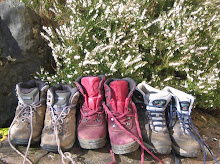
With their bottle-green heads and exotically ornate tail feathering, cock Pheasants are currently busy strutting their stuff in the hope of catching the attention of any passing females. Most common in the north of the island, Pheasants are frequently encountered by many on Mull, but largely overlooked by most. Not regarded as the most intelligent of birds, having more beauty than brains, Pheasants often end up as road kill on the island, providing takeaway for Hooded Crows and Buzzards. However, such a close encounter may do little for the good looks of either bird or vehicle, as it has been estimated that hitting a Pheasant at 35 mph is akin to having a brick thrown through your car’s windscreen. Ouch!

As a precursor of those shady days of Summer, when sunlight struggles to filter its way through the canopy of Mull’s mighty Oaks, local woodlands have exploded into life under an April carpet of Lesser Celandines, Wood Sorrel and Wood Anemones (below). Long regarded as a relic of ancient woodland cover, the juice of this plant was formerly used to dye Easter Eggs for children. It is interesting that other authors depict every part of this rhizomatous perennial as being poisonous. Here, at Mull Magic, we prefer to err on the side of caution and stick to the big name brands, like Cadbury’s and Rowntrees, when it comes to choosing our Easter munchies!

One of the earliest ‘Spring’ moths that we have come across during our recent walks in North Mull is the Twin-Spotted Quaker. As a noctuid, its pale tawny-coloured forewings are substantially longer than they are deep. The double black spots near the base of each forewing give rise to this moth’s common name, but, as if some throwback to the 1960’s, its attraction lies in its Beatles-esque mop- topped appearance. The only generation of this moth is on the wing during late March and April, when it takes full advantage of the early nectar of emerging Willow catkins.

The felted ‘pussy-willow’ catkins of some Willows get their name on account of an apparent resemblance to cats’ paws - the ‘cat’ in the photograph below is of an endemic seven-pawed variety! Willows are among the first trees to burst bud in Spring on the Isle of Mull, when their flowers are a welcome source of sugar for any insects awakening from their Winter slumbers. Early flowering Willows are extremely important ecologically, serving as a food plant for a large number of adult moths and their larvae. It is, however, unknown whether they are a source of attraction to the occupants of any interplanetary craft that hover in the skies over the Isle of Mull at this time of the year!








